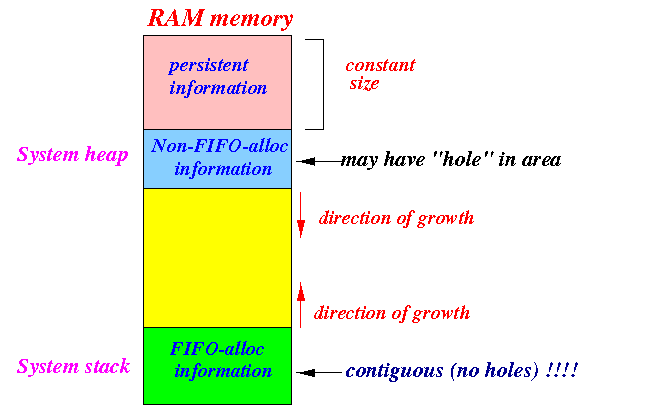- Instructions
(encoded using binary numbers) of a computer
program are stored in
the RAM memory -
(See: click here )

Alternate (more comprehensive) view of the content of the RAM memory:

(I am using a 1000000 byte RAM memory in the example - that's why the last address is 999999)
- Instructions
in a Java program
are static
while the program is running:
- The instructions of a Java program will not change for the entire duration that the Java program is executing
- Variables are
also placed in
RAM memory
Example: create one variable

We have used the memory cell with address 1000 to store the value of the variable
- $64,000 question:
- If we want to
create another variable,
how can the computer know
which memory cell to
use ???
- I.e.: how can the computer tell that the memory cell 1000 is now used (while previously, it was unused)
Answer:
- The computer program reserves
some RAM memory for
special system variables
in advance:
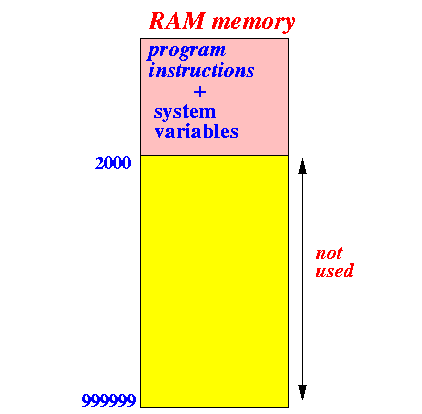
- One of these system variables will
remember the following
information:
- The start of the
unused portion of memory
- A list of memory locations that has been used.
Example:

- The start of the
unused portion of memory
- If we want to
create another variable,
how can the computer know
which memory cell to
use ???
- What happens when you create a
variable:
- Look up the
start of the
unused memory:
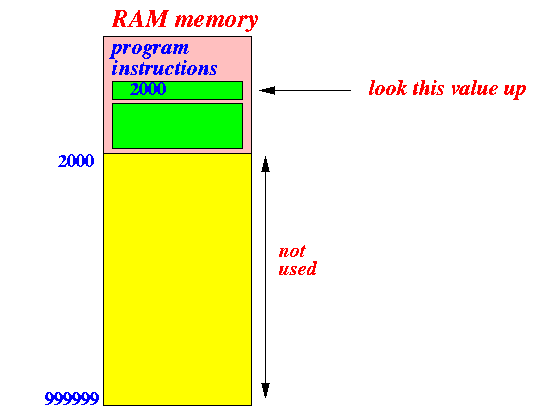
We find: 2000
- Check in the list of used memory location
if it is still unused:

- Reserve
memory location 2000 for the
variable by
marking the location 2000 as
used:

The next time a variable is created, the system knows that the memory location 2000 is used !!!
- Look up the
start of the
unused memory:
- Here is the situation after
creating 3 variables:

The memory locations 2000, 2001 and 2002 have been marked as used.
- If variable 1 is
destroyed,
the memory call 2000 is
no longer used.
Furthermore, the memory call can be re-used by some other variable !
- How to
destroy a
variable:
- We simply
remove the
memory location from the
used memory location list:

- We simply
remove the
memory location from the
used memory location list:
- Note:
- If the program creates
a new variable while
in this situation:

It can detect that memory call 2000 is not used and can re-assign this memory call to another variable !!!
- If the program creates
a new variable while
in this situation:
- Our current solution:
- We enter an
individual memory address in the
used memory location list
to indicate that the memory location has been used:

Problem with this approach:
- Need to use a large number of entries
- We enter an
individual memory address in the
used memory location list
to indicate that the memory location has been used:
- A more efficient solution:
use a range:

- If the process of
variable creation and
variable destruction has gone
on for some time, there will be
regions of
used and unused memory cells
all over the place in memory:

- I call this the Swiss cheese effect
- Note:
- We need to use 1 pair of addresses to record a used region of memory locations
- The is one special sequence
of variable creation and
destruction that
will not create holes
in the RAM memory:
- the Last In, First Out sequence:
- A variable that is created later is always destroyed first.
- the Last In, First Out sequence:
- Example:
- Create variable 1:
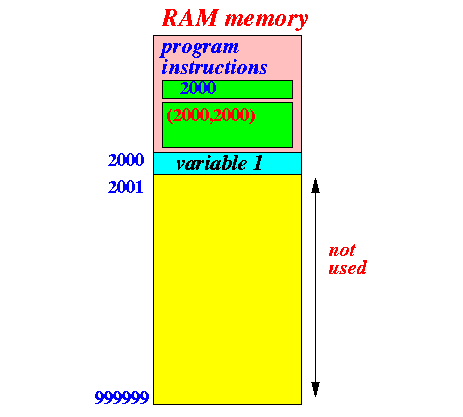
- Create variable 2:

- Create variable 3:

- When you destroy the variables
in the reverse order,
you preserve the region...
Destroy variable 3:

Destroy variable 2:

- Create variable 1:
- Stack:
- Stack = an area of RAM memory used for variables that are created and destroyed in a Last In, First Out (LIFO) manner
- Heap:
- Heap = an area of RAM memory used for variables that are created and destroyed in a non-LIFO manner
- Note:
- The name "stack"
is derived from the similarity with a "stack of book":

- The last book you put on a
stack sits at the
top (stack top)
- The first book that you
can remove without
causing the stack to collapse is
the book at the
top of the stack
- The sequence of book inserting and book deletion is Last In, First Out.
- The name "stack"
is derived from the similarity with a "stack of book":
- In order to use the computer RAM memory
as efficiently as possible,
the computer RAM memory
is organized
into 3 parts:

Explanation:
- Area 1 contains
information that are used
throughout the execution of the
entire program
(or what I call "persistent information")
Information stored in this area consists of 2 types of items:
- Computer instructions (you need all instructions in the computer program throughout its execution).
- Class variables (this kind of variables store information that is used throughout the program execution).
The amount of memory space in area 1 remains unchanged throughout the execution of the program !!!
- Area 2 contains
instance variables that
used by multiple methods
(long term information)
The space of Area 2 can grow or shrink:
- Area 2 will grow when the program creates new instance variable(s)
- Area 2 will shrink when some instance variable(s) is/are destroyed
- Area 3 contains
local and
parameter variables that
used by one single method
(short term information)
- Local and parameter variables are created when a method is invoked (starts executing)
- Local and parameter variables are destroyed when a method is returns (exits)
The space in Area 3 can also grow or shrink:
- Area 3 will grow when a method is invoked
- Area 3 will shrink when a method is returns (exits)
- Area 1 contains
information that are used
throughout the execution of the
entire program
(or what I call "persistent information")
- Direction of growth of
the areas 2 and 3:
- In order to use the
available RAM memory
as efficient as possible,
the direction of growth
of areas 2 and 3 is
towards each other
Graphically:

- In order to use the
available RAM memory
as efficient as possible,
the direction of growth
of areas 2 and 3 is
towards each other
- Consider the following computer program:
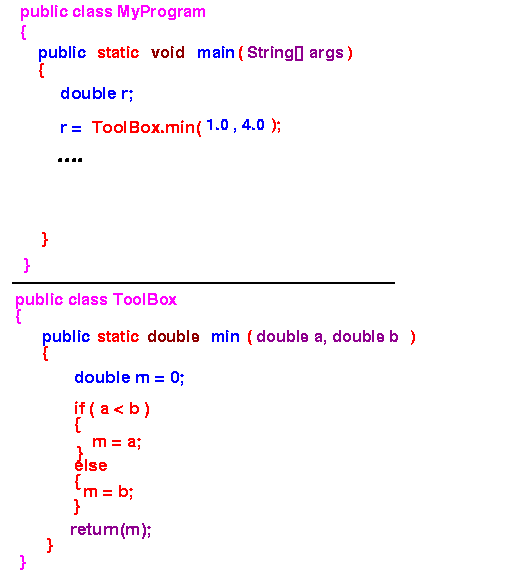
- When a
program first starts running,
the computer RAM memory will only
contain
the persistent information
I.e., only the program instructions and class variables are stored in RAM:
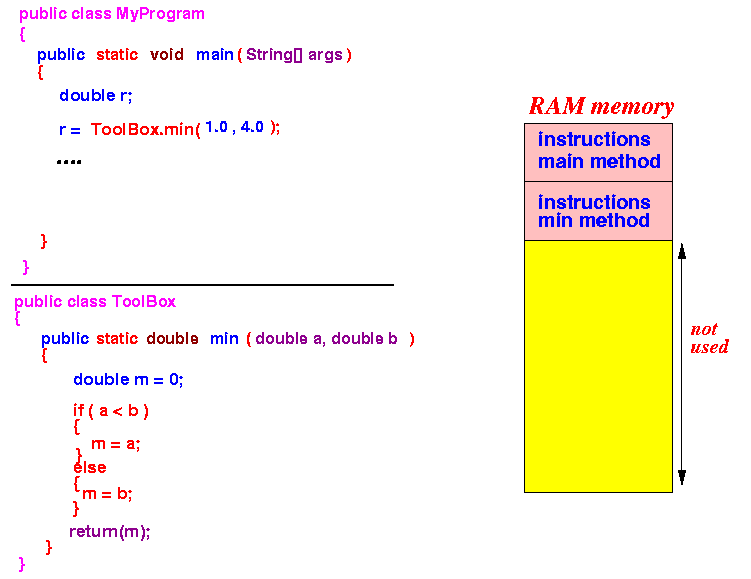
(Since we do not learned about class variables, our example only has program instructions)
- The area 2 and area 3 will grow and shrink depending on whether some variables are created and destroyed.
- It is possible that the
area 2 or
area 3 grows
so large that
the RAM memory becomes
exhausted:
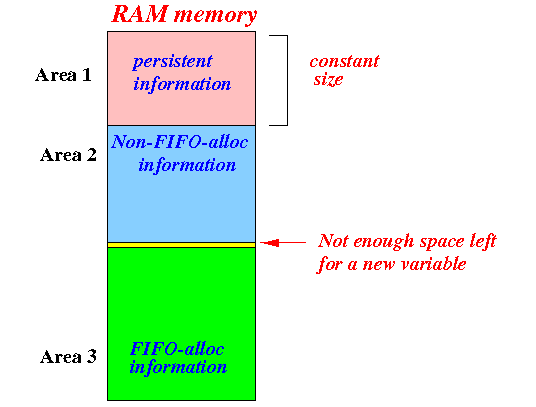
- Out-of-memory error:
- When you try to
create a variable
and the computer has run out of
unused RAM memory,
it will cause a
out-of-memory error
- The program will terminate immediately
- When you try to
create a variable
and the computer has run out of
unused RAM memory,
it will cause a
out-of-memory error
- Some situations that can
cause out-of-memory errors:
- The program
has an infinite loop and
inside the loop,
the program
creates a new variable
- When we discuss recursion later in the course, I will warn you about the "infinite recursion" scenario that can cause out-of-memory errors.
- The program
has an infinite loop and
inside the loop,
the program
creates a new variable
- Later in the course, you will learn that
the sequence of variable creation and
destruction in
area 3 is
LIFO
Therefore:
- Area 3 is a
stack !!!
In fact, this region of memory is called the System stack
(There are no "holes" of unused regions in this area)
- Area 3 is a
stack !!!
- Area 2 however,
is a heap
This area is called the System heap.
- Summary:
